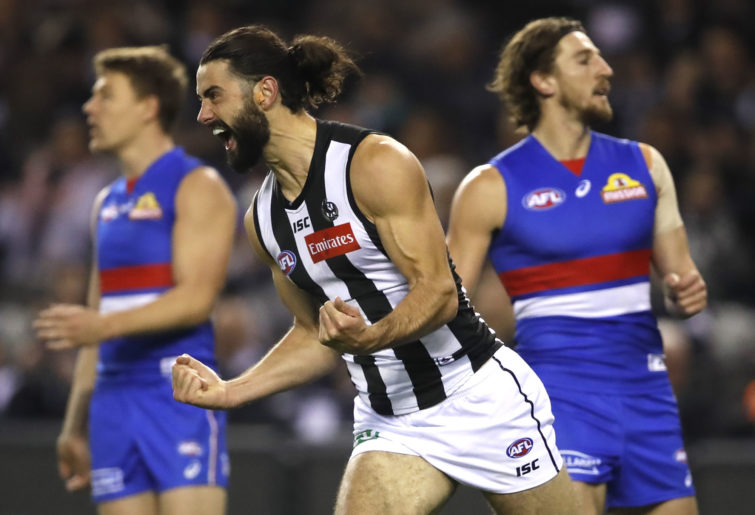The Collingwood Football Club is good at assembling workman-like sides, teams that are greater than the sum of their parts.
I saw this frequently through coach Tommy Hafey’s tenure from 1977-82. At that time, Collingwood’s administration was spendthrift so the list comprised a handful of champions, a handful of promising young players, and a lot of battlers.
While they had opportunities to win flags in the grand finals they contested – particularly in 1977, 1979, and 1981 – they invariably fell short. Some might say they lacked the skill to compete over one hundred minutes with better teams. Or it could be they lacked the ruthlessness. Or it could be both. Whatever the case, they were ultimately found lacking.
Mick Malthouse assembled similar squads for Collingwood’s 2002-03 grand final assaults. You could never question their fighting spirit. When they clicked – as they did in 2002 – they would not leave you wondering as to whether they’d given it their all. When they didn’t click – as they didn’t in 2003 – the sum of their parts were exposed. A number of players did not survive that scrutiny.
The 1990 Collingwood premiership side is underrated in terms of talent – from the mercurial Peter Daicos, to the tenacious Gavin Brown, to the exciting Mick Guane – this list goes on.
The side was replete with great players. Due to injuries or other circumstances, some never built on 1990 as a base or sustained the form from that season. The club as a whole unravelled through the ’90s, which depreciates the way some of these players are remembered.
But the side as a whole was united through a ruthlessness of intent – a fire lit, nurtured and fueled by coach Leigh Matthews. Before the 1990 grand final, captain Tony Shaw told the playing group that he’d played in two losing grand finals, and he didn’t intend to play in a third. You look at the side who walked out: they wouldn’t be denied.
The 2010 premiership side is the best I’ve seen at the club in regard to talent. Every line had at least one gun.
The midfield comprised the likes of Luke Ball, Scott Pendlebury, Dane Swan, and Dale Thomas – before his ankle injury, Thomas was one of the best midfielders in the game.
Up forward, they had Travis Cloke, who was the best power forward in the league. Down back they had Ben Reid – a brilliant centre half-back who could read the play, led the league in intercepts, and was a surgical kick.
Young key positioners such as Chris Dawes and Nathan Brown were full of promise. Then you had an array of dashing and/or skilled flankers, such as Leon Davis, Alan Didak, Heath Shaw, Heritier Lumumba, Dayne Beams, and Steele Sidebottom.
It was a very unCollingwood side.
Coming out of that era, the Pies rebuilt to launch their next premiership assault. Their early drafting (netting the likes of Brodie Grundy, Ben Kennedy, Tim Broomhead, Jackson Ramsey, Nathan Freeman, and Matthew Scharenberg) netted only the one hit: Grundy. Their trading (picking up Clint Young, Quinten Lynch, Patrick Karnesis, Jordan Russell, and Jesse White) found not one mainstay.

Brodie Grundy (Dylan Burns/AFL Photos via Getty Images)
The list management created an abscess primarily responsible for the struggles of 2013-17, which still affects them to this day.
For the most part, they’ve been much better with their list management in recent years, picking up the likes of Jordan de Goey, Brayden Maynard, and Jaidyn Stephenson, but have constantly had to speculate with a Moneyball-like approach to fix other list issues.
Due to a dearth of key positioners, they recruited 30-year-old Melbourne full-back Lynden Dunn, and then succeeded him with 28-year-old Jordan Roughead from the Bulldogs. They brought 26-year-old Jeremy Howe across originally to play as a lead-up forward, but he was moved into defence to fill a hole.
They rookied 25-year-old defender Brody Mihocek, and then out of necessity flung him up forward. And they international-rookied 24-year-old Mason Cox, and have tried to convert him into a full-forward.
Then they’ve banked on trades and recycled players, such as Taylor Adams, Jeremy Howe, Travis Varcoe, Jack Crisp, Will Hoskin-Elliott, Chris Mayne, Daniel Wells, and also snared John Noble in the mid-season draft to address yet another hole in their best 22. There are also a handful of rookies in the current build, such as Rupert Wills and Jack Magden.
But when this assemblage is pitted against teams who’ve taken talent out of the top end of the draft – players who’ve become proven stars – the differential is obvious.
Consider this list of key forwards:
• Richmond: Jack Riewoldt and Tom Lynch
• West Coast: Josh Kennedy and Jack Darling
• Bulldogs: Tom Boyd and Jake Stringer
• Hawthorn: Buddy Franklin, Jarryd Roughhead, and Jack Gunston
What do they have in common?
They were high draft picks who’ve played in the last seven flag sides. The Bulldogs are as close to an outlier as you can get in that list, but the grand final just happened to be the game that Tom Boyd – a number one draft pick – chose to showcase his talent.
The Magpies’ key forwards in the 2018 grand final were a rookie defender and an international rookie who didn’t even know what football was five years ago.
Collingwood did well to contend in 2018 and 2019, and they’re rated to do so again in 2020, but looking at the list build, it feels like one of those sides cobbled together under Tom Hafey – a handful of stars, a handful of promising young talent, and a lot of role players who, collectively, are greater than the sum of their parts.
They’re full of spirit, they play with intensity, they won’t leave you wondering, but when the game is on the line, do they have the edge physically or psychologically to find a way to win it against the best?
That’s open to debate.





























































































